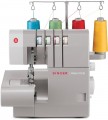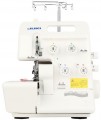Type of sewing machine
The general type of sewing machine, which determines its functionality and specific application.
—
Electromechanical. The classic, simplest type of sewing machines: they do not have computer control, all operating parameters are adjusted mechanically, and their use is limited to the simplest types of seams.
-
Computerized. Sewing machines equipped with built-in computers that control the sewing process. Thanks to this, they have a more extensive set of functions and are more precise in setting than electromechanical ones, although they cost accordingly. Note that in this case we mean exclusively computerized sewing machines; embroidery and sewing-embroidery machines are divided into separate categories (see the corresponding paragraphs).
—
Embroidery. Such machines were initially intended only for embroidering patterns, and are practically not suitable for work outside this specialization (regular sewing, hemming). They have appropriate design features, are equipped with a hoop and embroidery feet, and are often equipped with both a set of built-in presets (for example, embroidering letters of the alphabet) and the ability to connect to a PC and download patterns.
—
Sewing and embroidery. Machines that can be used for both sewing and embroidery. The design and sewing capabilities are similar to computerized
...models (see the corresponding paragraph), but are complemented by an embroidery unit, hoop and other embroidery equipment. And the built-in capabilities usually include both basic embroidery elements (crosses, stars, satin stitch, etc.) and the ability to embroider using patterns downloaded from a computer. Such machines are very versatile, but in terms of specific capabilities they may be inferior to more specialized models.
— Overlock. A special type of sewing machine designed primarily for seaming and trimming the edges of materials. An overlocker covers the edge of the fabric with a special seam, which prevents fraying, fraying and deformation. One of the design features of such devices is the presence of several working threads, from 2 to 10 (most often 3 or 4).
— Coverstitching machine. Devices designed to create the so-called. cover stitch - a flat elastic seam that is most often used to hem the folded edge in knitwear, as well as in some types of joints. Such machines are not used for other purposes.
— Coverlock. Devices that combine an overlocker and a cover stitching machine in one housing. For more information about each of these varieties, see the corresponding paragraph. Here we note that a carpet lock is actually a universal tool for processing edges: it is capable of overcasting them, cutting off excess fabric and hemming the folded edge with a cover stitch. In addition, many modern carpet stitchers are also capable of stitching materials (mainly with a two-thread chain stitch).Number of stitches
The number of stitches that a sewing machine can sew. The larger this number, the more extensive the capabilities of this model, the wider the choice the user has; however, it wouldn’t hurt to clarify the specific range of supported stitches separately.
The fewest options - mostly up to 25 - are provided in electromechanical machines, as well as specialized devices such as overlockers and carpet lockers (see “Type”). In computer-controlled devices, the number of lines can be in the dozens, and some also allow you to download additional options from the computer.
Max. presser foot height
Distance from the working surface to the foot in the uppermost position. Must be taken into account when working with thick fabrics.
Sewing speed
The maximum sewing speed provided by the sewing machine. In the vast majority of models, this parameter can be adjusted, so if necessary, you can sew at a lower speed.
The more stitches a machine makes per minute, the higher its productivity, the better suited it is for large volumes of work. At the same time, it is worth considering that high speed has a corresponding impact on price and energy consumption, and it is not always required. Detailed recommendations on choosing the optimal speed for certain types of work can be found in special sources.
Features
—
Вышивание букв алфавита. Возможность вышивания букв алфавита с помощью машинки. Данная функция встречается в моделях с компьютерным управлением, она осуществляется за счет набора букв, занесенного в память машинки. Многие модели с такой возможностью имеют несколько встроенных шрифтов, а некоторые даже позволяют загружать свои шрифты с компьютера.
—
Дифференциальный транспортер. Транспортер для ткани, состоящий из двух зубчатых реек — перед и за иглой. В зависимости от выставленного режима такой транспортер может дополнительно растягивать или, наоборот, собирать ткань во время шитья; первое пригодится при работе с плотными тканями, второе — для трикотажа, стрейча и других легко тянущихся материалов.
—
Реверс. Функция, позволяющая переключать направление движения ткани под иглой и, соответственно, направление шва. Применяется в основном для закрепления строчки. Реверс является практически обязательным для швейных машин в классическом смысле слова — электромеханических, компьютеризированных и швейно-вышивальных (см. «Тип»), а вот в других типах практически не встречается.
— Рукавная платформа. Приспособление для работы с рукавами, штанинами и прочими аналогичными деталями одежды. Эта функция чаще всего реализуется за счет съемной части рабочего столика — при ее снятии столик превращается в узкую платформу. Конкретная ширина такого прис
...пособления может быть разной, ее стоит уточнять отдельно.
— Нитевдеватель. Специальное приспособление, предназначенное для того, чтобы облегчить процесс вдевания нитки в иголку. Наличие нитевдевателя особенно полезно при частной смене ниток (например, шитье попеременно разными цветами).
— Нитеобрезатель. Механизм для обрезания нитей после окончания шитья, избавляющий от необходимости использовать ножницы: для обрезания нитки достаточно нажать кнопку. Отметим, что речь идет именно об автоматическом нитеобрезателе; ручные приспособления, устанавливаемые на корпуса некоторых машинок, в данном случае нитеобрезателями не считаются.
— Шитье без педали. Возможность использовать машинку без подключения педали. Для запуска и остановки процесса в таких моделях, как правило, предусматривается специальная кнопка. Подобная возможность может пригодиться при длительном шитье, когда держать педаль постоянно нажатой было бы утомительно, и при эпизодическом использовании, когда машинка запускается «на пару стежков» и возиться с подключением педали особо незачем.
— Шитье двойной иглой. Возможность применения машинки для шитья двойной иглой — парой игл, закрепленных в одном держателе. Существуют разные виды таких игл и разные приемы работы с ними, а некоторые работы выполняются только двойной иглой. В любом случае для использования подобных приспособлений требуется, чтобы машинка была изначально с ними совместима.
— Позиционирование иглы (верх/низ). Переключатель, позволяющий пользователю выбрать, в каком положении будет находиться игла после остановки двигателя — верхнем или нижнем. При отсутствии такого выключателя игла, как правило, останавливается только в верхнем положении, а это не всегда удобноPower consumption
The power consumed by the machine during operation. Usually, the maximum power value is indicated in the characteristics.
Most of the electricity supplied to the machine is consumed by the engine, so this indicator primarily describes the power of the engine. The higher this power, the faster the machine can work and the better it is suitable for working with dense fabrics. However, there is no strict dependence here, much also depends on the general specialization of the unit.

